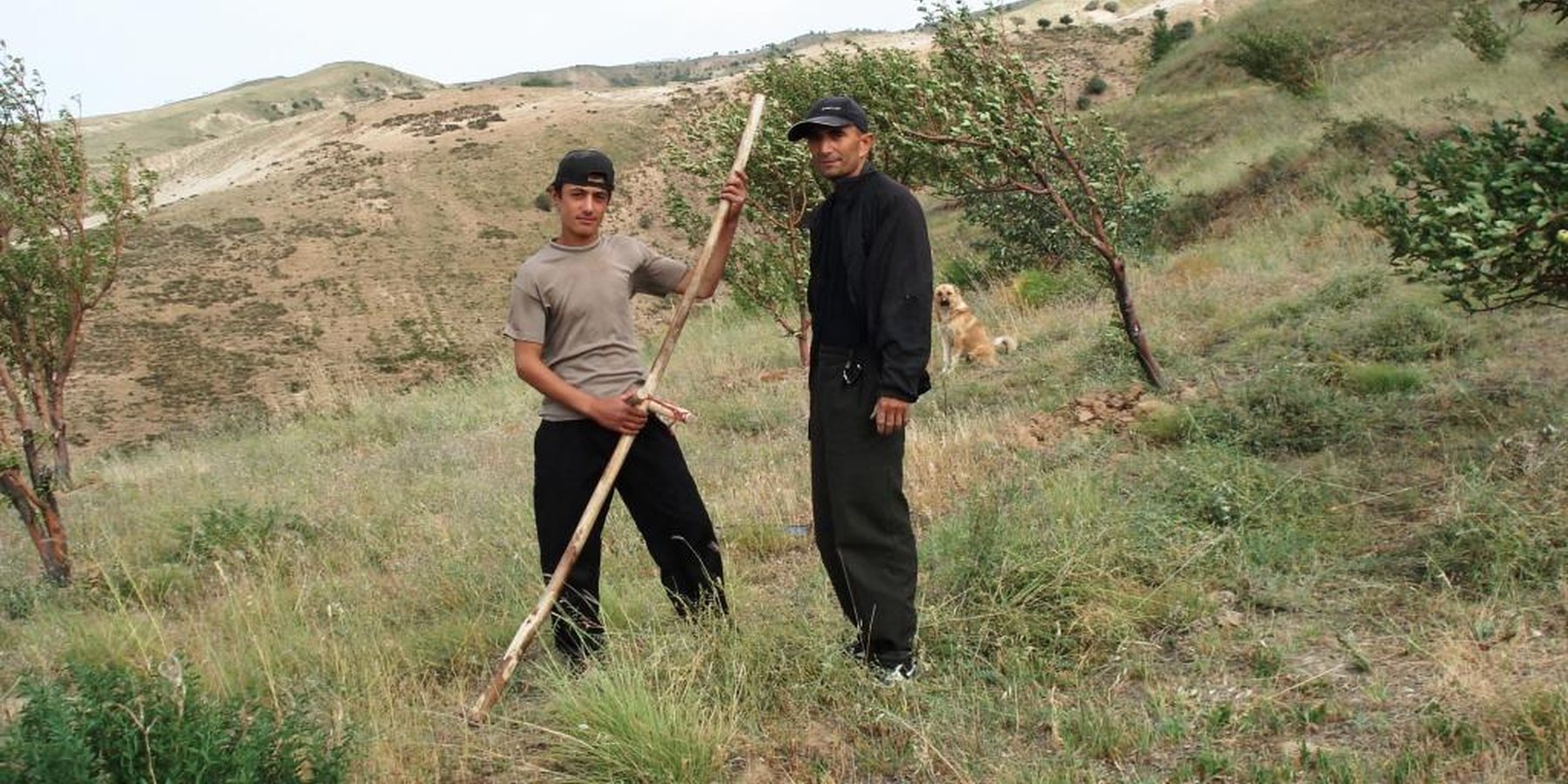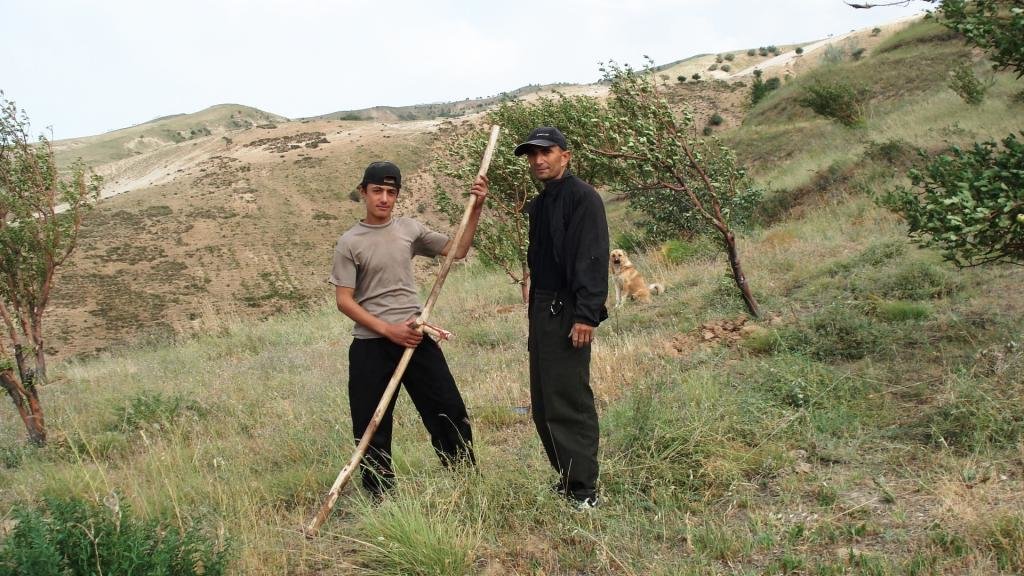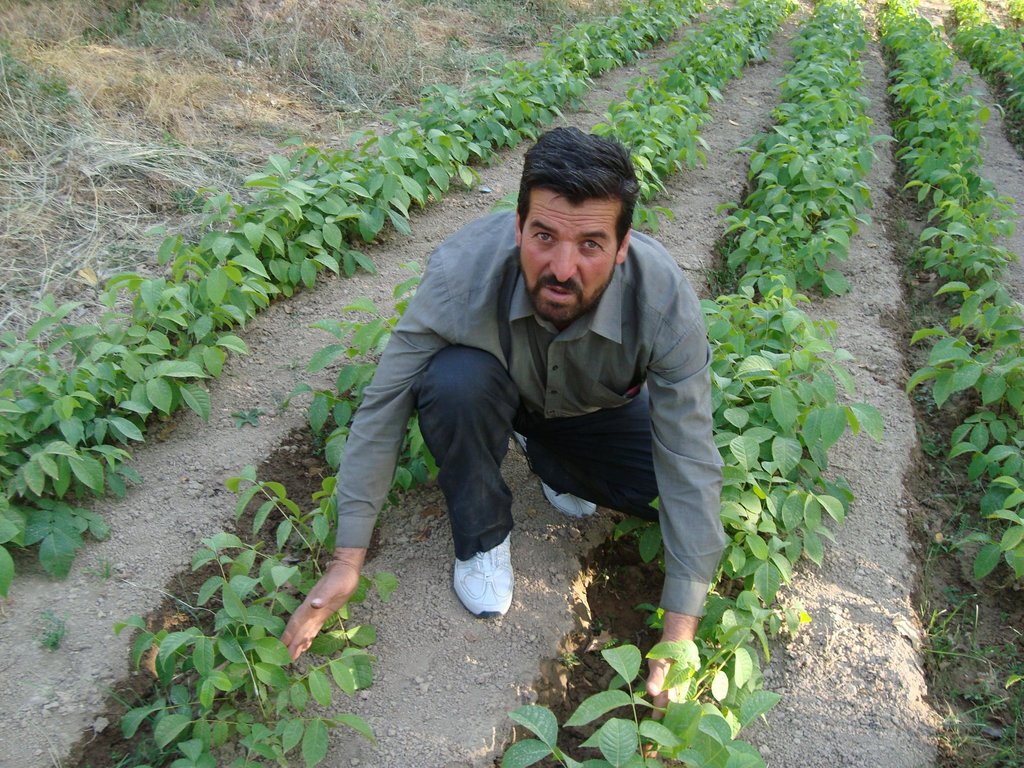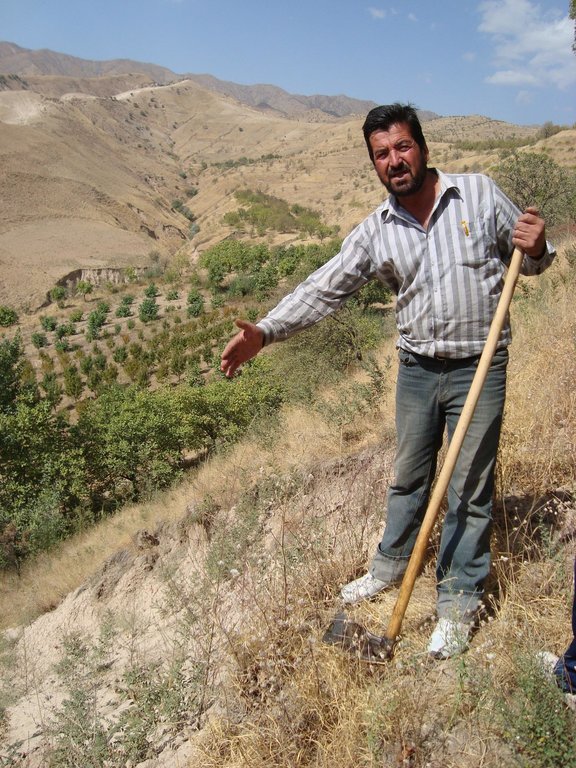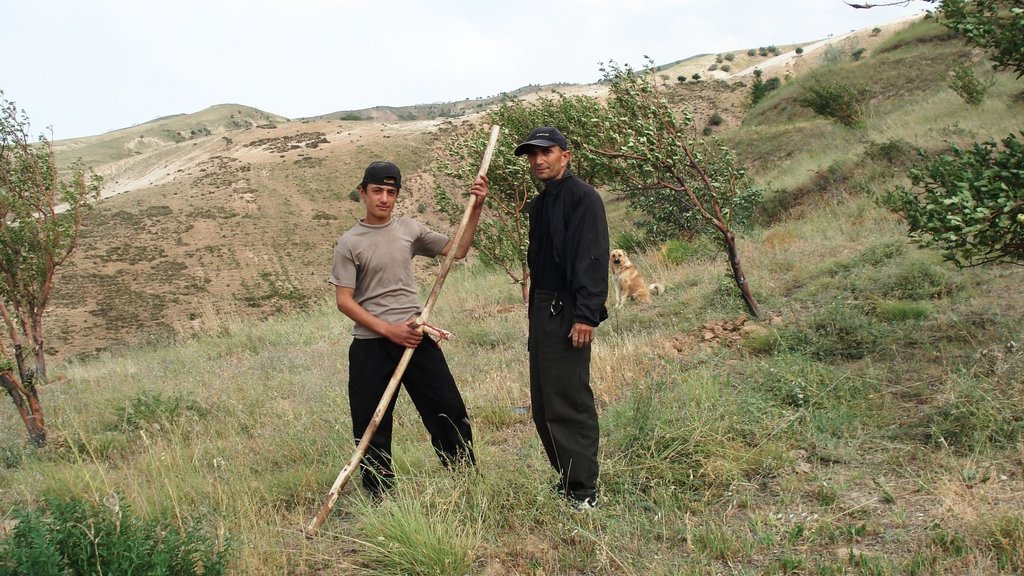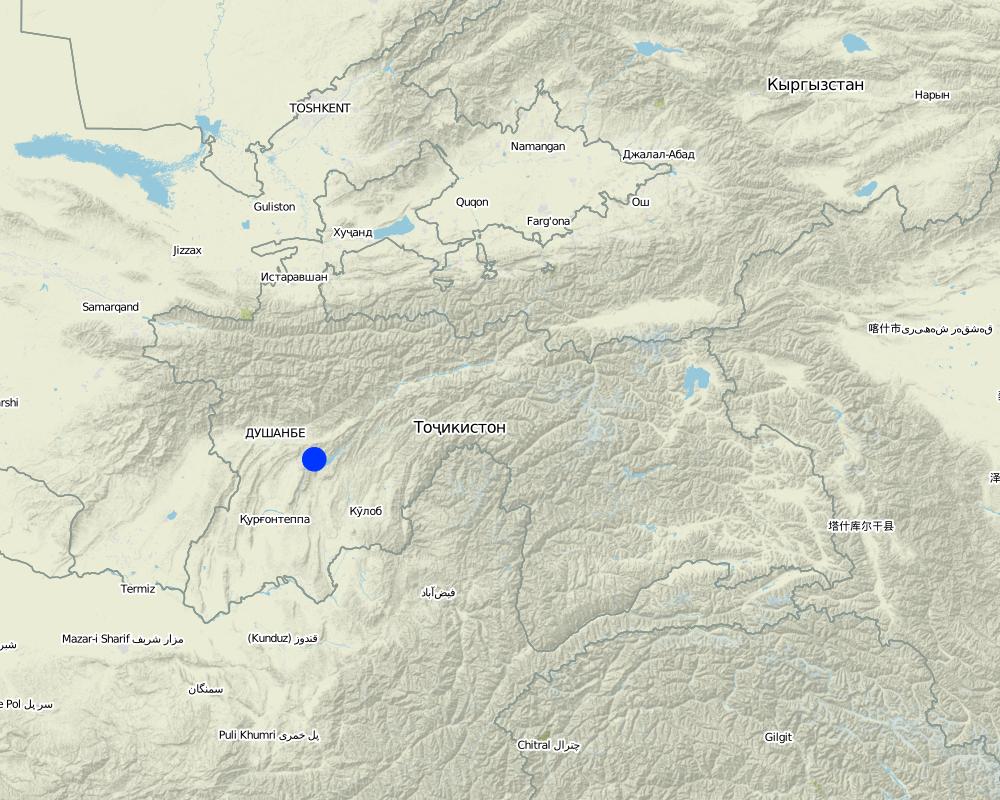State-controlled research territory for orcharding [Tajikistan]
- Creation:
- Update:
- Compiler: Christian Wirz
- Editor: –
- Reviewer: David Streiff
approaches_2566 - Tajikistan
View sections
Expand all Collapse all1. General information
1.2 Contact details of resource persons and institutions involved in the assessment and documentation of the Approach
Name of the institution(s) which facilitated the documentation/ evaluation of the Approach (if relevant)
CDE Centre for Development and Environment (CDE Centre for Development and Environment) - Switzerland1.3 Conditions regarding the use of data documented through WOCAT
When were the data compiled (in the field)?
20/08/2008
The compiler and key resource person(s) accept the conditions regarding the use of data documented through WOCAT:
Yes
1.4 Reference(s) to Questionnaire(s) on SLM Technologies
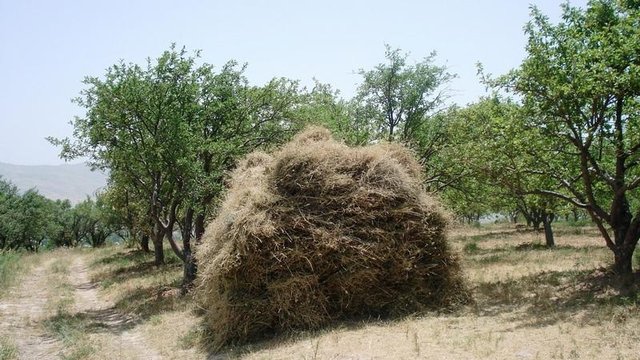
Combined cut-and-carry and fruit-production system with terraces [Tajikistan]
A combination of fruit- and nut-trees together with seminatural trees and shrubs on one side with grass-communities on the other side provide for a diversified production system.
- Compiler: Christian Wirz
2. Description of the SLM Approach
2.1 Short description of the Approach
Cultivation of an orchard with research activities and research staff with food for work.
2.2 Detailed description of the Approach
Detailed description of the Approach:
Aims / objectives: The main objective is to dispose of varieties of fruits that are adapted to different conditions. Another objective is to prevent degradation and test methods of rehabilitation and to spread this knowledge. The orchard was also implemented as a source of labour for 50 employees. In the last years it has become more important to acquire self-sufficiency by fruit- and hay-production, because wages cannot always be paid. And because of limited state-support in terms of fertilisers, pesticides and machines, the selling of tree saplings is important.
Methods: Work is subdivided into research, whereby the analysis of soils is carried out in laboratories, into conservation methods carried out by field staff and the brigadier himself (planting fruit and other trees, grafting fruit trees, planting and maintaining tree saplings, combatting pests and forbs) and harvest (of fruits and hay) that is carried out by all the employees and their families. The fruits are partly dried and sold.
Stages of implementation: After the terraces being built and the trees being planted in the early 1960ies, the orchard needed to be maintained: e.g. annually trees are substituted and fertilisers, manure and pesticides are applied. When trees are not grown, intercropping is possible. Since 1992 soils on the terraces, between the trees, are not tilled anymore, because rees are too high.
Role of stakeholders: The workers are initially employed for a clearly defined work such as tractor driver, research coordinator or research scientist. They execute orders given by their superiors. In the years after independance the strict subdivision is broken up and the research station is more independent. During civil war, when the district government was nearly inexistant, the land needed to be distributed among the employees, who were now land rentors and had to maintain their part of the orchard by themselves: It was the only way to protect the orchard from being destroyed, says the research coordinator.
2.3 Photos of the Approach
2.5 Country/ region/ locations where the Approach has been applied
Country:
Tajikistan
Region/ State/ Province:
Region of Republican Subordination
Further specification of location:
Faizobod
Comments:
The research area is subdivided into two parts, one in the higher hills (around 1800-1900m) and one close to the village Karsang. Only the latter is assessed, even if the applied technology and the approach are similar for both locations.
Map
×2.6 Dates of initiation and termination of the Approach
Indicate year of initiation:
1965
2.7 Type of Approach
- project/ programme based
2.8 Main aims/ objectives of the Approach
The Approach focused mainly on SLM with other activities (In the last years production (of fruits and young trees) for market and self-sufficiency has increased.)
The field station should elaborate knowledge on fruit-production in steep areas. The knowledge gained on terraces would also be useful in the 1970ies, when forest administration was implemented and started to adopt and adapt the terrace technology. Research was in cooperation with other regions of Tajikistan and the URSS, e.g. good walnut varieties from Ukraine were imported and bred to make them adapted to local climate. From the very beginning it was important integrate and to create a surplus value for local population, be it jobs or knowledge on erosion prevention and fruit-production. In the last years it has become more important to spread conservation and production knowledge in favour of local population: Workshops are regularly organised, together with NGOs and with the own specialists, to make population share the gained knowlegde and apply it in their own orchards.
The SLM Approach addressed the following problems: The main focus was research on the productivity and stress-resistance (e.g. droughts) of different varieties of fruit-trees and vines under different climatic conditions. Another important objective is the elaboration of efficient terrace technology against erosion.There were also particular interests of political leaders such as vineyards for wine-production, a factor that is not important anymore in a country where the Islamic religion seems to be more important today than in Soviet times.
2.9 Conditions enabling or hindering implementation of the Technology/ Technologies applied under the Approach
legal framework (land tenure, land and water use rights)
- enabling
The existing land ownership, land use rights / water rights greatly helped the approach implementation: Land belonged to the state in former USSR and the state initiated the project.
knowledge about SLM, access to technical support
- hindering
Topography (very steep slopes) difficult for mechanical use and dangerous for tractor drivers.
Treatment through the SLM Approach: Terraces reduce slope and besides being a better wind-protection planting the trees diagonally to the main slope direction is a
3. Participation and roles of stakeholders involved
3.1 Stakeholders involved in the Approach and their roles
- local land users/ local communities
Women are considered to be responsible for work in the household, even if they are sometimes the main field-workers today
- SLM specialists/ agricultural advisers
by SLM specialists alone (top-down): Implementation and control of implementation. They are also encharged of research.
- national government (planners, decision-makers)
According to national and Soviet agricultural policies, the orchard was designed and organised.
Decision to implement research station (Academy of Science)
No women are found in a leading position of this research station.
3.2 Involvement of local land users/ local communities in the different phases of the Approach
| Involvement of local land users/ local communities | Specify who was involved and describe activities | |
|---|---|---|
| initiation/ motivation | none | |
| planning | none | |
| implementation | passive | Tractor-driver for terraces and field staff for tree-planting, land users' families for harvesting. |
| monitoring/ evaluation | none | |
| Research | none |
3.4 Decision-making on the selection of SLM Technology/ Technologies
Specify who decided on the selection of the Technology/ Technologies to be implemented:
- SLM specialists alone
Explain:
Different experts are the decision-makers, depending on the problem (e.g. type of fruits). This has stayed till today.
Decisions on the method of implementing the SLM Technology were made by by SLM specialists alone (top-down)
4. Technical support, capacity building, and knowledge management
4.1 Capacity building/ training
Was training provided to land users/ other stakeholders?
Yes
Specify who was trained:
- land users
- field staff/ advisers
Form of training:
- demonstration areas
Subjects covered:
For land users it is interesting to learn specific technologies in fruit-production, e.g. how walnut saplings are maintained. For field staff it is interesting to learn from specialists how something is explained to different participants (young, old).
4.2 Advisory service
Do land users have access to an advisory service?
No
4.3 Institution strengthening (organizational development)
Have institutions been established or strengthened through the Approach?
- no
4.4 Monitoring and evaluation
Is monitoring and evaluation part of the Approach?
Yes
Comments:
bio-physical aspects were regular monitored by project staff through observations; indicators: Stress-resistance, depending on climate
economic / production aspects were regular monitored by project staff through measurements; indicators: Fruit harvest per tree.
There were few changes in the Technology as a result of monitoring and evaluation: With reduced crop harvests, partly due to lacking irrigation and partly to tall trees, cropping was stopped. Instead haymaking was focused.
5. Financing and external material support
5.1 Annual budget for the SLM component of the Approach
Comments (e.g. main sources of funding/ major donors):
Approach costs were met by the following donors: government (In the past government paid): 100.0%
5.2 Financial/ material support provided to land users
Did land users receive financial/ material support for implementing the Technology/ Technologies?
No
5.3 Subsidies for specific inputs (including labour)
- equipment
| Specify which inputs were subsidised | To which extent | Specify subsidies |
|---|---|---|
| machinery | ||
- agricultural
| Specify which inputs were subsidised | To which extent | Specify subsidies |
|---|---|---|
| seeds | ||
| fertilizers | ||
If labour by land users was a substantial input, was it:
- food-for-work
Comments:
There are fix employees with monthly salaries. But often, instead of salaries, people are paid in kind (i.e. the fruits for own use are substracted from the salary).
The government paid the whole implementation of the technology.
5.5 Other incentives or instruments
Were other incentives or instruments used to promote implementation of SLM Technologies?
No
6. Impact analysis and concluding statements
6.1 Impacts of the Approach
Did the Approach help land users to implement and maintain SLM Technologies?
- No
- Yes, little
- Yes, moderately
- Yes, greatly
Cover recovered on a nearby ex-cropland area, where the orchard technology was applied. It is especially the grazing-stop that triggered the change.
Did other land users / projects adopt the Approach?
- No
- Yes, little
- Yes, moderately
- Yes, greatly
In the 1970s the forest department began with state-organised reforesting and terracing. Nowadays land users visiting workshops in the research station adopt the orchard technology, but just for self-sufficiency.
Did the Approach lead to improved livelihoods / human well-being?
- No
- Yes, little
- Yes, moderately
- Yes, greatly
Especially the employees could profit from their job, be it by payments in kind or by the wages. During civil war the decision to leave the cultivation of the orchards to local land users did not only
Did the Approach help to alleviate poverty?
- No
- Yes, little
- Yes, moderately
- Yes, greatly
The salaries allowed some land users to buy private livestock.
6.2 Main motivation of land users to implement SLM
- increased production
Especially in recent years workers have been relying more and more on harvests (fruits, hay).
- prestige, social pressure/ social cohesion
The employees made their living with this job.
- environmental consciousness
The brigadier was and is convinced that the ecosystem is maintained by the whole project.
6.3 Sustainability of Approach activities
Can the land users sustain what has been implemented through the Approach (without external support)?
- uncertain
If no or uncertain, specify and comment:
Already today organisations carrying out workshops or training activities are asked to pay for it: food, paper and pens for the participants have to be organised.
6.4 Strengths/ advantages of the Approach
| Strengths/ advantages/ opportunities in the land user’s view |
|---|
| The strong focus on research helps improve the orchard. (How to sustain/ enhance this strength: Inputs from external experts (from Switzerland) could help improve the technology.) |
| Strengths/ advantages/ opportunities in the compiler’s or other key resource person’s view |
|---|
| It helps spread knowledge on an efficient conservation technology, especially on tree planting. |
| It permits land users to learn conservation methods and to make their living at the same time. (How to sustain/ enhance this strength: Giving the land users more decision capacities might strengthen their will to implement conservation.) |
6.5 Weaknesses/ disadvantages of the Approach and ways of overcoming them
| Weaknesses/ disadvantages/ risks in the land user’s view | How can they be overcome? |
|---|---|
| The chaos of war could have destroyed the orchard (people chopping trees illegally in a situation of no control). | The possibility of employees to rent land (land tenure assured) was the only possibility to save the orchard (as soon as the harvest goes to the land user, he has more interest to improve the land use). |
| Weaknesses/ disadvantages/ risks in the compiler’s or other key resource person’s view | How can they be overcome? |
|---|---|
| Research activities and the improvement of conservation technologies depend very much on the research coordinator. | Strengthening the position of land users would help make the system more sustainable on the long-term |
Links and modules
Expand all Collapse allLinks

Combined cut-and-carry and fruit-production system with terraces [Tajikistan]
A combination of fruit- and nut-trees together with seminatural trees and shrubs on one side with grass-communities on the other side provide for a diversified production system.
- Compiler: Christian Wirz
Modules
No modules


